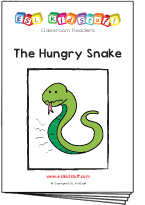Past tense activities – Irregular verbs: Part 1 lesson plan
Stand-alone lesson ESL kids lesson plan
Lesson plans for ESL kids teachers
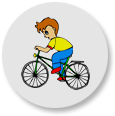
Past tense activities – Irregular verbs: Part 1
In this lesson students practice using the past simple tense with some common irregular verbs. Students talk about what they did yesterday, do some fun activities and sing a song.
Members get accompanying flashcards, worksheets, song and classroom reader.
Download materials:
Our lesson plans are FREE!
Sign up for accompanying:
✔ worksheets
✔ homework sheets
✔ craft sheets
✔ flashcards
✔ song downloads & videos
✔ classroom readers & videos
Click to see lesson details, materials and supplies
Time: 40 mins – 1 hour
Objectives: Talking about yesterday using past tense irregular verbs.
Structures: “What did you do yesterday?”, “Yesterday, I …(verb)”.
Target vocabulary: yesterday, woke up, ate, drank, went, sang, swam, had, came back, rode, did, put on, slept, breakfast, milk, school, song, pool, fun, home, bike, homework, [hide_on_uk]pajamas[/hide_on_uk][hide_on_us]pyjamas[/hide_on_us], all night.
Lesson materials
Flashcards:
- wake up, eat, drink, go to school, sing, swim, star jump (use this for “have fun”), go home (use for “come back home”), ride a bike, do homework, put on, sleep
Printables:
- What did you do yesterday? worksheet
- Past irregular verbs worksheet
- What did you do yesterday? song poster
Songs:
- What did you do yesterday? (Past irregular verbs)
Additional materials:
- Past activities 1 vocab crossword
- Past activities 1 vocab word search
- Past tense match (Irregular 1) worksheet
Supplies:
- [hide_on_uk]colored[/hide_on_uk][hide_on_us]coloured[/hide_on_us] pencils
- an empty plastic bottle (for the “Spin the bottle” game)
- 2 balloons (for the “What did you do yesterday? line up” game)
- a blindfold (for the “Blindfold guess” activity)
- Blu-Tack or tape to stick flashcards to your board
- board with marker / chalk
- device to play the song on
This is a part one of a two-part lesson (lesson 2 follows on here).
In this lesson students will practice using the past simple tense with some common irregular verbs.
IMPORTANT: This lesson should be taught after the past regular verbs lesson.
Past tense verbs come in two forms, regular and irregular. Regular past tense verbs are easy to form – you add “ed” to the end of the verb (e.g. I play guitar –> I played guitar). Irregular verbs however, are not formed so simply and have no consistent form. Therefore, their past tense forms have to be learned.
Here are some common irregular verbs with their past tense forms:
wake up –> woke up
eat –> ate
drink –> drank
go –> went
sing –> sang
swim –> swam
have –> had
come –> came
ride –> rode
do –> did
put –> put
sleep –> slept
give –> gave
write –> wrote
read –> read
run –> ran
Lesson procedure:
Warm up and maintenance:
The beginning of your lesson is extremely important: this is where you set the tone of your lesson and get everyone in the right frame of mind for learning English. It is also an opportunity to check homework and review previous lessons.
Click for warm up suggestions for the start of your lessons
These activities can be done in the following order at the start of your lesson:

1. Greetings and name tags
Greet the students by name as they enter the classroom and gesture for them to sit down. Before class prepare some blank name tags (stickers or pin-on tags). Give these out and have everyone write their names and put their tags on. If you use pin-on tags, you can keep and give out every class.

2. Homework check
Check each student’s homework set in the last lesson. Ask each student some questions about their homework worksheet (e.g. “what [hide_on_uk]color[/hide_on_uk][hide_on_us]colour[/hide_on_us] is it?”), give lots of praise, and then put some kind of mark on the homework sheet (e.g. a sticker, a stamp or draw a smiley face). Finally, tell your students to put their homework back into their bags.
3. Review past lessons
Reviewing past lessons is very important – students need constant practice of new vocab, structures, songs, games and so on. Always review parts of your last lesson as well as some parts from other previous lessons. You can spend 5-10 minutes reviewing – it’s fine to recycle games and activities from your past lessons to review as kids enjoy playing familiar games (although be careful not to play a game to death!). See the section “Other ideas to include in your warm” below for ideas.
You can also include review activities in the main body of your lesson. Kids can have short attention spans so it’s good to be able to pull out lots of activities during different stages of the lesson.
Other ideas to include in your warm up:
Ball pass questions
This is good to review questions from previous lessons. Get everybody standing in a circle.
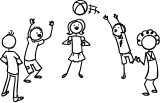
Round 1:
Take a ball and hold it and say, “My name is (you name)”. Then throw the ball to one student and say, “What’s your name?”. Students throw the ball around randomly, saying their names and asking for names.
Round 2:
This time ask a review question, e.g. “How many tables are there?”. Then throw the ball to a student who should answer, “There are (6) tables”. Help if necessary. Then that student throws the ball to another student and asks a “How many …?” question. Continue so everyone has a go. You can have multiple rounds with different topic questions.

Play “Spin the bottle”
Sit students in a circle with a bottle in the middle. Teacher spins the bottle. When it stops spinning the student it is pointing to has to answer a question. If the answer is correct then that student can spin the bottle. This is a good class warm up activity (e.g. How are you? What’s your [hide_on_uk]favorite[/hide_on_uk][hide_on_us]favourite[/hide_on_us] food? How’s the weather today?, etc.
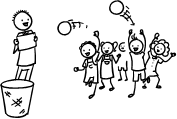
Play “Vocabulary basketball”
This is a fun game which reviews vocabulary from previous lessons. You will need a basket (a trash can) and 2 balls (or 2 pieces of A4 paper scrunched up into balls).
Form 2 teams and line them up so that two players from each team are facing the front with the basket in front of them. Let both players throw their ball – if they get their ball into the basket they can try and win a point by giving the correct answer to a question the teacher asks. This can be an actual question (e.g. What are you wearing?) or a flashcard (What’s this?). Then they go to the back of the line. At the end, the team with the most points is the winner!
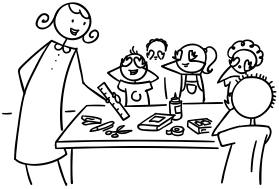
Play “What’s missing?”
This is a fun review memory game – students will have to try to remember review objects from previous lessons (e.g. classroom stationery). Lay the objects out on a table for all to see. Allow the students a minute to memorize the positions of the objects. Remove an object and hold it behind your back. Say, “Open your eyes!” – the first student who can shout out the missing object wins a point for his/her team. Play for all the objects.
Finally, calculate which team has won the most points and give them a round of applause.

Play “Quiz game show”
This is a fun quiz game, like a simple version of a TV game show. Draw some circles on the board and randomly write numbers 1, 2 or 3 in each circle. These will be points.
Put students into teams. Then ask the first team to choose a number – 1 is an easy question (e.g. “Do you like bananas?”) and 3 is a difficult question (e.g. point at a clock and ask, “What time is it?”). 2 will be in between in terms of difficulty. When the question has been answered correctly, erase that number circle. Play until all the number circles are gone – the team with the most points is the winner!
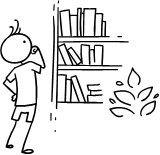
Read a classroom reader again
As you progress through the lessons you will start to build up a catalog of classroom readers (see our Readers download page at https://www.eslkidstuff.com). Kids love going back to old stories and reading through them again. Invite a student to pick a classroom reader and read through it as a class. Make the story as interactive as possible by asking questions (e.g. what [hide_on_uk]colors[/hide_on_uk][hide_on_us]colours[/hide_on_us] there are, the names of different objects, etc.) and getting students to speculate what is going to happen next in the story.

Talk about the weather (do after you have taught the weather lesson plan).
- Prepare a weather board. Before the first class prepare a piece of cardboard and cover it with felt – you are going to pin this to the wall. If you can, try and get blue felt (to represent the sky). Write at the top in large letters, “How’s the weather today?”. Below that write “Today it’s”. Cut out weather pictures (such as our weather flashcards) and stick some velcro on the back. Arrange the weather pictures around the edge of the board and then put the board on the wall of your classroom. You can now use this weather board at the beginning of every lesson.
- Ask about the weather. Ask, “How’s the weather today?” and have students put up their hands. Allow one weather condition per student (e.g. “It’s rainy”) and have each student come up and put a weather picture on the weather board.
- Introduce more weather vocabulary. Depending on weather conditions, you can introduce more weather words (with pictures … you can get students to draw them), such as:
- stormy
- misty
- showery
- freezing
- humid
- frosty
- icy
- drizzly
New learning and practice:
1. Review past tense regular verbs – “Spin the bottle” game
Your students will have covered some regular verbs using the past tense form in a previous lesson. Let’s begin this lesson with a review of these by playing a fun game of “Spin the bottle”.
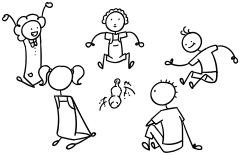
Have everyone sit in a circle. The teacher starts by spinning a plastic bottle in the middle of the circle. Whoever the bottle points at when it stops spinning is shown one the regular verbs flashcards (from the previous lesson) – make sure no one else sees the flashcard. That student must then say, “Yesterday I …” and act out the verb on the card. Everyone has to guess what he/she is doing and shout out the correct verb in the past tense (E.g. “jumped in puddles”). Play until you have practiced all of the verbs on the cards.

2. Review the structure, “Yesterday, I verb+ed“
On the board, draw a vertical line down the middle, dividing the board into two equal halves. Stick the regular verb flashcards from the spin the bottle game onto the left-half of the board. Tell your students you are going to ask each person “What did you do yesterday?” and they have to give an answer using one of the verb flashcards on the board using, “Yesterday, I …” and their answer must be true. Go around the class and get everyone to give you an answer. Also, ask at least one extra question to each student (e.g. “What did you watch on TV?”).
3. Teach vocab for irregular verbs in the present and past tense form
Before class, print the following flashcards: wake up, eat, drink, go to school, sing, swim, star jump (we’ll use this for “have fun”), go home (use for “come back home”), ride a bike, do homework, put on, sleep. Divide the class up into groups of 3 or 4 and divide the flashcards between the groups.
Next, on the right-side of the board draw 12 circles. Students will be sticking the flashcards inside the circles, so make them just big enough to fit the cards inside. Under each circle write verbs as follows:
- wake up – woke up
- eat my breakfast – ate my breakfast
- drink my milk – drank my milk
- go to school – went to school
- sing a song – sang a song
- swim in the pool – swam in the pool
- have fun – had fun
- come back home – came back home
- ride my bike – rode my bike
- do my homework – did my homework
- put on my [hide_on_uk]pajamas[/hide_on_uk][hide_on_us]pyjamas[/hide_on_us] – put on my [hide_on_uk]pajamas[/hide_on_uk][hide_on_us]pyjamas[/hide_on_us]
- sleep all night – slept all night

Invite a student up with one of their flashcards and ask him/her to place it into the correct circle on the board – their team-mates can help. A lot of the vocabulary will have been studied in previous lessons so your students should be able to get the correct answer for most of the circles – if not, you can help by saying, “no, try again” until the student has stuck the card into the correct circle. Keep going until all of the flashcards have been stuck on the board in the circles.
Next, chorus each verb three times (e.g. Teacher: “wake up, woke up”, Students “wake up, woke up” … 2 more times). Don’t worry at this stage if your students don’t understand why there are two versions of each verb – we’ll come to that next.
Finally, write the word “Yesterday” at the top of the board and draw a red circle around it (or a different [hide_on_uk]color[/hide_on_uk][hide_on_us]colour[/hide_on_us] to the [hide_on_uk]color[/hide_on_uk][hide_on_us]colour[/hide_on_us] of the word) and chorus “Yesterday”. Point at the first flashcard and say, “Yesterday, I wake up. Is that ok? Wake up?”. Try and get someone to say the correct form “Woke up”. Circle the word “woke” in red (to signify this is the correct form of the verb to use with the word “Yesterday”). Now go through all of the remaining verbs asking your students which is the correct form and circling the past tense version in red.
4. Pair practice: saying past tense irregular verbs
In pairs, students are going to say the infinitive and past tense of the verbs together – once with both students looking at the board and the second time with one student looking away from the board (being tested).
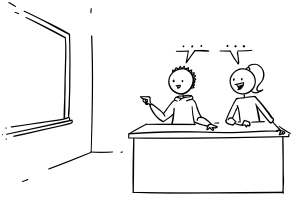
First round: Put students in pairs. Start by modeling the activity with another student and both sit looking at the board. Teacher starts by saying the infinitive form of a verb and his/her partner has to say the past form with the phrase, “Yesterday, I …”, for example:
Teacher: drink my milk.
Student: Yesterday, I drank my milk.
Teacher: ride my bike.
Student: Yesterday, I rode my bike.
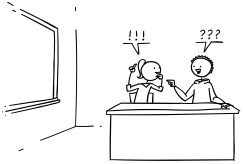
Once everyone understands what to do, have the pairs go through all of the verbs, changing roles after all the verbs have been practiced so both get the chance to say the past forms.
Second round: Keep everyone in the same pairs, however one student must sit with their back to the board. Students do the same thing but the student with his/her back to the board must try and remember the correct past tense form – their partners can help if they get stuck. Again, change roles. Once finished, get everyone to find a new partner and try again, one with their back to the board.
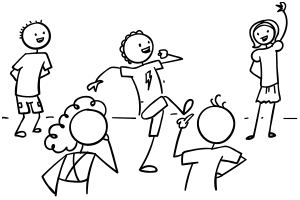
5. Play “Past tense charades” in small groups
Start by modeling: look at the flashcards on the board (including the regular verbs on the left-side) and do an action or gesture. Elicit what you are doing using the structure “Yesterday, I …” (e.g. “Yesterday, I kicked a ball”, “Yesterday, I slept all night”).
Then put everyone in small groups of 3 or 4. One person in each group starts by acting out a verb and the other members have to shout out the correct answer using the structure “Yesterday, I …”. The first person in the group to say the correct answer can do the next action. Continue until each group has completed actions for all of the verbs.
6. Play “What did you do yesterday? line up”
Divide the class into two groups and have each group form a line, so that both teams are lined up facing each other. To begin, each team is going to race to pass a balloon up and down the line with the winning team the first to get the balloon passed back to the first student. Give a balloon (or rolled up paper ball) to the first member of each team. Say, “Ready, steady, go!”. Each team races to pass the balloon, hand-to-hand, up and down the line.
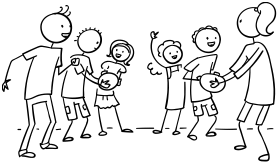
Next, give everyone a verb flashcard (use all the irregular verbs first). Explain that each time you pass the balloon you have to ask, “What did you do yesterday?” and when you receive the balloon you have to say, “I (ate my breakfast)” depending on the flashcard you have been given. Both teams race, passing the balloon and saying the structures. You can play other rounds with different rules, such as:
- teams must pass the balloon without using their hands (e.g. under chins, between knees, etc.)
- teams can only tap the balloons – they can’t hold them in any way
- teams have to kick or head the balloons but not hold
7. Sing the “What did you do yesterday?” song
The first time you play the song, put up the What did you do yesterday? song poster on the board. Quickly elicit the vocab. Play the song and sing along doing the gestures, as described below. Play 2 or 3 times.
Lyrics for “What did you do yesterday?”
Chorus:
What did you do?
What did you do yesterday?
Verse 1:
I woke up (woke, woke, woke)
I ate my breakfast (ate, ate, ate)
I drank my milk (drank, drank, drank)
And then I went to school.
Chorus:
What did you do?
What did you do yesterday?
Verse 2:
I sang a song (sang, sang, sang)
I swam in the pool (swam, swam, swam)
I had lots of fun (had, had, had)
And then I came back home.
Chorus:
What did you do?
What did you do yesterday?
Verse 3:
I rode my bike (rode, rode, rode)
I did my homework (did, did, did)
I put on my [hide_on_uk]pajamas[/hide_on_uk][hide_on_us]pyjamas[/hide_on_us] (put, put, put)
And then I slept all night.
Gestures for “What did you do yesterday?”
The gestures are simple and fun to do, matching the verbs in the song.
Chorus:
- hands together, rocking your arms back and forth in time with the music
Verses:
- I woke up: stretch and yawn
- I ate my breakfast: pretend to eat cereal with a spoon
- I drank my milk: pretend to drink
- And then I went to school: walking on the spot and waving goodbye
- I sang a song: arms outstretched in a singing position
- I swam in the pool: pretend to swim
- I had lots of fun: wave your hands in the air while smiling
- And then I came back home: knocking on an imaginary door
- I rode my bike: do a cycling motion
- I did my homework: pretend to write
- I put on my [hide_on_uk]pajamas[/hide_on_uk][hide_on_us]pyjamas[/hide_on_us]: pretend to put on a [hide_on_uk]pajamas[/hide_on_uk][hide_on_us]pyjamas[/hide_on_us] top and button it up
- And then I slept all night: do a sleeping gesture
[hide_on_uk]Short sample (members get full-length song):
[/hide_on_uk]
[hide_on_us]Short sample (members get full-length song):
[/hide_on_us]
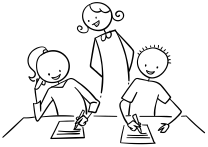
8. Do the “What did you do yesterday?” worksheet
Give out the worksheets and have everyone draw and write about what they did yesterday – make sure everyone understands that these are their true answers. Circulate as everyone is working away, and ask lots of questions (e.g. What’s this?, What did you do yesterday? Did you ride your bike?, etc.).
When everyone has finished, go around the class asking everybody to tell you some things they did yesterday.
9. Play “Blindfold guess”
This is a really fun game to conclude the lesson – you will need a blindfold. Get everyone to form a large circle and give everyone a verb flashcard (tell everyone to keep their flashcard secret and not to show anyone).

Next, invite one person to volunteer to be blindfolded. Once the blindfold is on, spin him/her around in the middle of the circle and then tell him/her to go forward and ask the person they first bump into, “What did you do yesterday?”. That person needs to answer the question, based on his/her flashcard. However, s/he can speak in a funny voice to avoid being identified. Then the blindfolded person must guess who it is. Play so that everyone has a turn to be blindfolded.
Wrap up:
Assign homework: “Past irregular verbs” worksheet
Click for wrap up suggestions for the end of your lessons

1. Assign homework
Each week give out a homework worksheet for your students to take home. Hold up the homework worksheet and model how to do it. Give out the worksheets and say, “Put your homework in your bags”.

2. Do “Quick check”
Time to leave the class. Make sure everything is put away and the students have gathered their belongings. Have them line up at the door and place yourself between the door and the students. For each student check one new word or phrase, for example:
- hold up an object or flashcard (such as an item of clothing) and ask, “What’s this?”
- ask a question from the lesson (e.g. “Where do you live?”, “Do you like bananas?”, “Can you play chess?”, etc.)
When they give you the correct answer say goodbye and let them leave. If their answer is wrong, have them go back to the end of the line – they will have to try again once they reach the front!
Other lesson plans
Actions, verbs & tenses:
- Can – for ability
- Morning routines
- Daily routines & times of the day
- Actions – Present continuous
- Future plans using “going to”
- Past tense activities – Regular verbs
- Past tense activities – Irregular verbs: Part 1
- Past tense activities – Irregular verbs: Part 2
Adjectives:
- Describing people
- Describing things
- Comparing things (Comparative adjectives)
- Comparing things (Superlative adjectives)
Adverbs:
Alphabet:
Animals:
Body:
Classroom:
Clothes:
Colors:
Colours:
Directions:
Family:
Feelings & emotions:
Food:
Health & sickness:
Holidays & festivals:
Jobs:
Likes, dislikes & favorites:
Likes, dislikes & favourites:
- Likes & dislikes
- [hide_on_uk]Favorites[/hide_on_uk][hide_on_us]Favourites[/hide_on_us] and asking why
Nature & Our world:
Numbers:
Places & where we live:
Prepositions of location:
Pronouns:
Shapes:
Shopping:
Sports:
Time, days, months, seasons:
Toys:
Transport & travel:
Weather:



